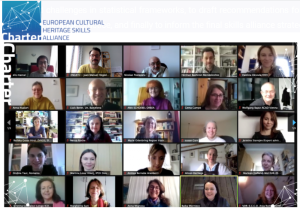 A summary account of the work the CHARTER Alliance went through during our first official workshop encounter, virtually hosted from Riga, is outlined by Elis Marçal.
A summary account of the work the CHARTER Alliance went through during our first official workshop encounter, virtually hosted from Riga, is outlined by Elis Marçal.
[brainstorming sessions included] …cultural heritage ecosystem case: an ethnological museum; a municipal historical archive; an industrial heritage site; a crafts training centre…
The European Cultural Heritage Skills Alliance (CHARTER) writes:
Our vision for the cultural heritage skills future:
The CHARTER Alliance consortium aims to draft an innovative and holistic landscape that allows us to describe the European cultural heritage sector where society and all its stakeholders’ roles become visible as they engage with cultural heritage, from communities to experts, from politicians to cultural mediators.
A model that will allows us to conceive a sector interpreted beyond the value chain models often used to assess business models or production processes. Enabling us to illustrate the continuous interdependency and interconnectedness nature of cultural heritage and society, as we author and care for these inherited resources and they inform and shape our own identity and lives.
By laying out a depiction of the continuous life cycle from awareness and recognition to its care and management, its use and broader understanding by all in a wide variety of heritage practices. Which will encompass the myriad of cultural heritage network of stakeholders and their synergies, depicting a sector intrinsically based on the relationship and on-going dialogue between cultural values and their significance to communities in their social and temporal context.
This landscape will give us the matrix to assess the sector dynamics and stakeholders synergies, to identify professions and competences required, to design and propose educational programmes, for policymaking recommendations, to assess and identify needs and challenges in statistical frameworks, to draft recommendations for mobility, to foster quality provision of education and training for heritage practice, and finally to inform the final skills alliance strategy for the sector.
The 2 brainstorm sessions in Riga
The Riga meeting brought together the full CHARTER Alliance consortium for the first time since we had met in our global kick-off meeting in January. We’re joined with a common goal, a discrete purpose and working plan – Start drafting our cultural heritage landscape model in a participatory venture.
It was a unique and extraordinary opportunity to gather members for 3 days of joint reflexion, open dialogue and free discussions about our perception of our daily professional practice in the cultural heritage sector.
Inspired by presentations on the cultural heritage policy background where we currently stand, the shared experiences from other projects and an overview of the methodological pathways we will have to trail, we were also invited to brainstorm on the landscape we will develop for our CHARTER strategy.
The brainstorm sessions were all about how we describe ourselves and how we perceive the European cultural heritage sector, by drafting a picture of what our landscape looks like.
The two main sessions were designed to take participants on a journey of self-assessment and enquiry of what makes their role specific to cultural heritage as each one brings their own knowledge and expertise to preform a role in this wider shared stewardship for cultural heritage.
Cultural heritage functions and competences session
In a bottom up approach, firstly participants were asked to identify and describe their own main activities and competences as they are about in their professional practice. Then to look around to other partners and start to identify similarities, common capacities, realizing that we all fall into these big families of activities which are heritage driven, as we collectively preform specific functions towards cultural heritage on behalf of society. On a second phase a draft model was proposed and participants were asked to evaluate and test its conceptual assumptions.
This joint process of drafting a group of functions around and towards cultural heritage allowed participants to enquiry the whole model and how well it illustrates the infinite inter relations between us and cultural heritage.
Cultural Heritage case ecosystems session
On the second session participants were invited to undertake a stakeholder approach in a cultural heritage ecosystem case: an ethnological museum; a municipal historical archive; an industrial heritage site; a crafts training centre; an immigrant memory space; the restoration of an emblematic monastery; an archeological site; a castle in a natural reserve. A real life scenario was presented and participants were to add examples of stakeholders, probable outputs and include more examples of the full range of activities and processes required to the full realisation of each case both economically and socially. Ultimately the exercise required them to focus on some examples and inspired by the previous session, gather sets of activities and tasks as they relate to the fulfillment of each case undertaken, and consequently the types of knowledge and skills this would necessitate.
Drafting CHARTER cultural heritage landscape
CHARTER team had prepared a first draft based on the evaluation of previous reports, European frameworks and different models describing value chain process, which was tested in this collective exercise. This participatory process guarantees a collective insight and will mirror the variety of national structures, professional backgrounds and congregate consortium expertise.
The brainstorm sessions as a dual procedure benefited from both the individual experience of each participant as well their integrated contribution when they engage in collective strategies towards cultural heritage. The body of intelligence, experience and comments retrieved are the basis for further analysis, reflexion and synthesis in the pursuit of drawing and describing our comprehensive cultural heritage landscape.
Our next steps will focus on revising and improvement of the assumptions tested, within our consortium and during our activities. As it constitutes our matrix for further interrogation on skills, competences and professions as well on learning paths and education and training provision, and ultimately our matrix for the overall sector assessment and drafting of the final skills alliance.
For more background see charter-alliance.eu

